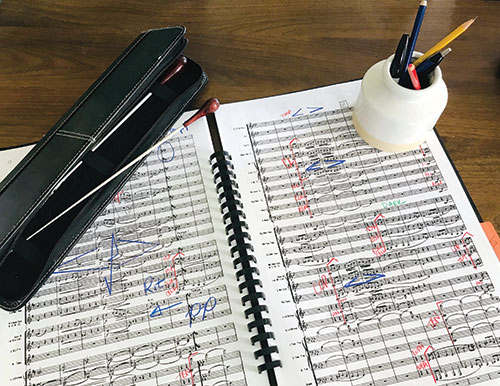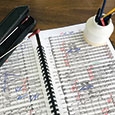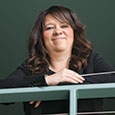
An artist by definition uses a medium to express something – generally an emotion or reaction. This form of communication is unique as practiced by musicians and visual artists, particularly in a world that emphasizes verbal and written communication. As musicians, we call ourselves artists, and indeed we are. Growing up, I was a quiet student who preferred to remain unnoticed and was known as the smart, but silent girl to most of my peers. Looking back, it is no wonder that I gravitated toward music. My clarinet became the medium through which I could communicate with the world around me, allowing me to express myself without using my voice.
One of the more jarring aspects of becoming an ensemble director is your evolving identity as an artist, particularly if you no longer play your primary instrument as often (if at all). As a conductor, you play the band or orchestra, guiding the whole rather than just one part. However, it can be easy for conductors to lose track of the biggest opportunity we have to practice our artistry as musicians – literature selection. I have been guided by some of the most nurturing and motivating mentors in our field. Although each had different perspectives and strategies, the most important lesson I learned from all of them is that as a music educator, conductor, and scholar, I still have an artistic voice. This voice is put into practice when selecting the program for an ensemble and is one of the most sacred aspects of a music teacher’s job.
As conductors and music educators, our art lies in our programming. What you choose to have performed; the order you choose to perform it in; the time, date, location in which it is performed; and political and cultural context in which you choose to perform it all have implications for expressive meaning. We have a responsibility not only to select music that will be performed well, but also to select music that will impart knowledge to the performers and audience and (perhaps even more importantly) to select music that reflects our beliefs. Those beliefs could be anything from the universality of folk songs to varieties of pain to American influence.
Problems arise when you find yourself choosing works in a non-artistic way. When I started teaching, my colleagues and I would often rationalize our literature selection in these ways, thinking:
This will show off my clarinets.
The judges will love this.
I played this in college.
This composer is the latest trend.
This composer is a classic.
We’ll sound better than other bands because this has a bunch of fancy rapid runs.
This will be easy to teach.
This is not to say that none of these reasons are valid, but I think many reasons such as these are used without being backed up by a sound artistic philosophy. When repertoire is selected in this manner, we do a tremendous amount of damage. Not only are we selling ourselves short as artists, but we also impart a pseudo-artistry to the performers and audience. The implication is “this is good enough.” We unintentionally cheapen what we do. We, the performers, and the audience are so much more important than that and deserve more.
To give more, it might be time to reevaluate how you select music. As you listen, research, and study, consider what the piece and composer are expressing and whether it is done well. Is the music something you would listen to for fun and worthy of everyone’s time? If it fits these criteria – and will generate artistic growth for all involved – program it.
Literature selection is a challenge at every level, but teachers with limited resources probably have it the toughest. It is easy to feel that having an artistic philosophy seems like a luxury only available to wealthy schools or those working in higher education. On top of this, in many places, teachers have to select music from a prescribed list for contests, while worrying about judges, parents, and administrators, not to mention dwindling budgets and limited instrumentation.
It will take channeling your inner artistry and creativity to put together a beautiful program despite the obstacles. Michael Colgrass, reflected on this concept when he wrote about his experience composing the work Old Churches (written for middle school band), stating, “every composer knows that writing music within strict limitations is stimulating to creativity.” I would add that every music educator that is obligated to program within strict limitations has the opportunity to engage in similar creativity. Such creativity could manifest itself in any number of ways. It could be applied by finding an alternative way to work when construction has obscured you usual route, or finding recipes when you are put on a new diet. It could be applied to writing a grade three concert band piece with genuine artistic merit.
My teacher Eugene Corporon and I were chatting in the car on our way from a rehearsal in Dallas a few years ago, and I asked about his literature selection process. He often makes sudden changes to his planned program, but he has good reason for being picky and insistent. To paraphrase his response, “I only have a certain number of pieces left in me. The ones I pick need to be worth my time.” This is a worthy sentiment for everyone to adopt. Life is too short to teach and perform bad music. It can be a tall order to find those pieces that will show your students what artistic communication through music is, but that is why it is so important. You are more than just a music teacher going through the motions. You are helping to maintain the open dialogue of musical expression that we have been having as a human race for thousands of years. Don’t forget to be an artist – we need you.
Source
Composers and Children: A Future Creative Force? by Michael Colgrass (Music Educators Journal, vol. 91, no. 1, 2004, pp. 19-23).






